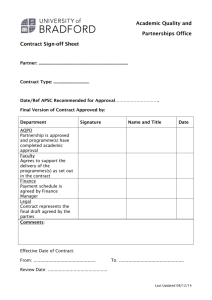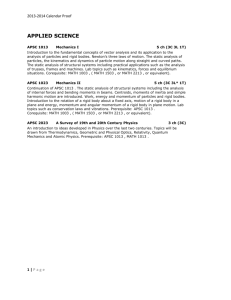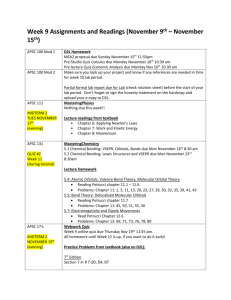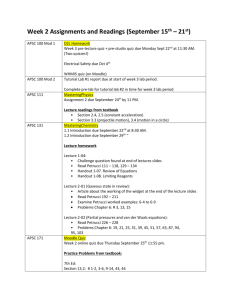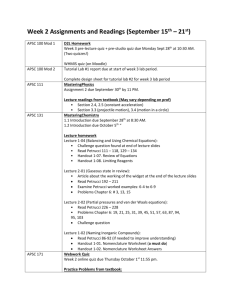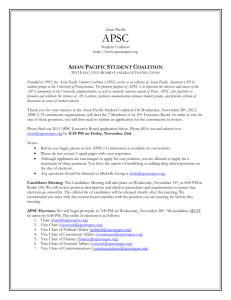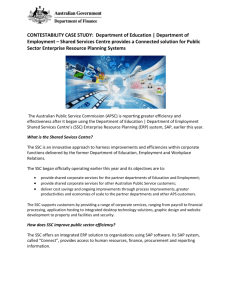Lecture 1-01: Chemistry Basics • Matter: anything that occupies
advertisement
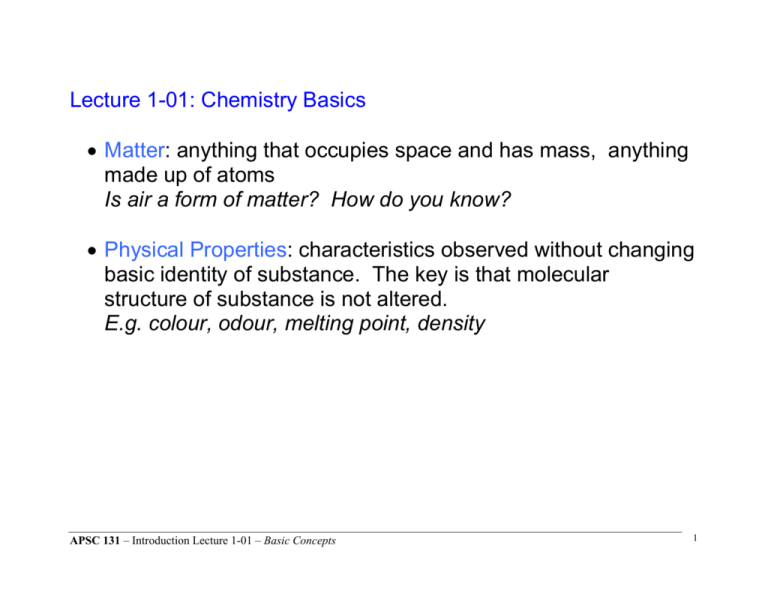
Lecture 1-01: Chemistry Basics • Matter: anything that occupies space and has mass, anything made up of atoms Is air a form of matter? How do you know? • Physical Properties: characteristics observed without changing basic identity of substance. The key is that molecular structure of substance is not altered. E.g. colour, odour, melting point, density APSC 131 – Introduction Lecture 1-01 – Basic Concepts 1 • Chemical Properties: any characteristic of a substance that involves ability (or inability) of substance to react to form other substances. The molecular structure of substance being studied (reactant) is altered if reaction occurs. e.g. flammability of carbon in oxygen gas e.g. non reactivity of Au in hydrochloric acid solution APSC 131 – Introduction Lecture 1-01 – Basic Concepts 2 • Intensive Properties: characteristic not depending on amount of substance present. They depend on the internal makeup of the substance. E.g. density, boiling point of a pure substance • Extensive Properties: characteristics depending on amount of substance present. E.g. mass, volume, heat content APSC 131 – Introduction Lecture 1-01 – Basic Concepts 3 Homogeneous: a substance composed of one phase and uniform in composition and properties throughout APSC 131 – Introduction Lecture 1-01 – Basic Concepts 4 Heterogeneous: a substance containing two or more distinct phases. Composition and physical properties vary from one part of mixture to another. APSC 131 – Introduction Lecture 1-01 – Basic Concepts 5 Physical Changes: process whereby a substance changes in physical appearance without changing basic identity (molecular structure is preserved). E.g. all changes of state liquid APSC 131 – Introduction Lecture 1-01 – Basic Concepts gas 6 • Chemical Changes: or chemical reactions involve transformation of substances into chemically different substances by rearrangement of atoms. Chemical change occurs when there is “change in composition”. reactants APSC 131 – Introduction Lecture 1-01 – Basic Concepts products 7 Classification of Matter: o matter is made up of elements found on periodic table o molecules of matter, like Lego bricks, can be pulled apart into atoms and rearranged into completely different molecules. Some commonly used terms are: • Atom: smallest particles or building blocks of matter • Molecule: particle formed by the chemical combination of two or more atoms APSC 131 – Introduction Lecture 1-01 – Basic Concepts 8 • Mixture: made up of two or more substances each with its own chemical identity. Homogeneous mixtures are solutions. • Pure substance: made up of one type of molecule and always homogeneous. May be an element or a compound. or APSC 131 – Introduction Lecture 1-01 – Basic Concepts 9 • Element: a pure substance made of one type of atom. Cannot be separated into simpler substances. or • Compound: a pure substance made up of two or more elements hooked together so that all molecules are identical APSC 131 – Introduction Lecture 1-01 – Basic Concepts 10 Matter Heterogeneous Mixture Several Phases Homogeneous Mixtures or Solutions Physical Separation Physical Separation Compounds Homogeneous Matter One Phase Pure Substances or Elements Chemical Separation APSC 131 – Introduction Lecture 1-01 – Basic Concepts 11 Suggested homework • Read Petrucci pages 1- 8 • Carefully read through lecture 1-02 on naming chemical compounds and try to answer any of the questions asked. • Problems Chapter 1: 1, 5, 7, 9, 11, 13 and 15 APSC 131 – Introduction Lecture 1-01 – Basic Concepts 12
